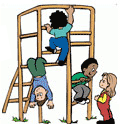Sponsored Links
Commands
Introduction:
Improves listening of English commands and practises verbs
What is learnt?
A good warm up game to get the children lively, active and quickly in to listening to English. As your lessons progress you can continue to add new words and phrases in. Since it uses TPR (Total physical response) it is very fun for the children and great for them to pick up the language quickly.
How the game is played:
Shout out some simple commands: "Stand up", "Sit down" "Hand's up" etc. To make it more fun you can try to trick them by saying sit down while they are already sitting, or you can also single children out who are not too active and no really listening by calling their name. Also commands can be split into Boys and Girls, again this can be fun and trick some students.
You can practise nearly all verbs in this game, such as: jump, spin, sing, eat, drink, cheer, clap
For later lessons or more advanced students adverbs can be added to the commands: such as big jump, little jump, slowly sit down, clap quietly, etc. You can also add songs, etc to this game to include stuff you have already taught your students and to make things fun and different.
Some other fun commands/charades can include:
Climb a mountain
Throw a big ball
Cheer your favorite football team
Do synchronised swimming
Dance with Tom Cruise
Paint a big picture
Row a canoe
Ride on a motorbike
Be a monkey
Fall in love
Be an English teacher
Eat many hot dogs
Walk like a model
Sing "happy birthday"
Eat hot soup
Be a big lion
Spin like a spinning top
Run like a penguin
Brush your hair
Swim in the sea
Cry loudly
Open the biggest book in the World
Walk underwater
Let's linedance
Dive into the water
Rock climb in the Grand Canyon
Touch you knees and smile
Walk like an elephant
Eat hot noodles
Stand on a balance ball
Shampoo your hair
Walk or run like an upset alligator
Train your muscles
Play the trombone
Towel on the head, take a hot spring bath
Swing quickly
Play the guitar and shout
Walk on a rope
Do the tap dance
You may also want to bring students to the front of the class to command the rest of the class, this can be quite interesting!
03.12.2006. 22:41
fgsdfgf,
What is the difference between learnt and learned? Both are variant of past tense of the verb 'to learn' You could've corrected "Hand's up" to Hands up
Fargas Smiley on 10.12.2007. 23:08
Main Entry:learnt
Pronunciation:\ˈlərnt\
chiefly British past and past participle of learn
wow. How unappreciative. Typing things like this takes time and is entirely for other people's benefit. I bet your your bad teachers, only interested in correcting.
 New Comments
New Comments
 Sponsored Links
Sponsored Links
 Other Languages - Learning Resources
Other Languages - Learning Resources
-
- Learn Chinese (Mandarin)
- Cantonese (Coming Soon)
If you have any games to add, or are would like to contact us for any other reason please use this form to do so.






 New Games
New Games
Write a comment